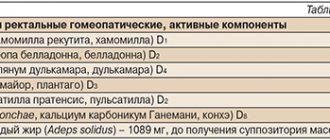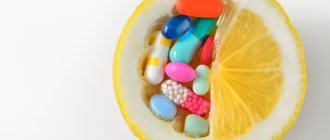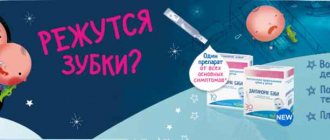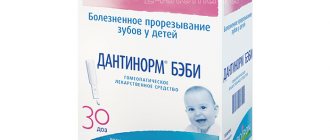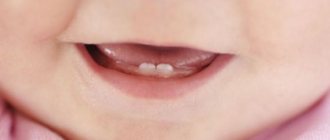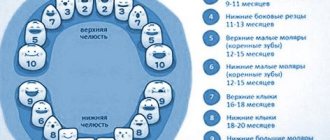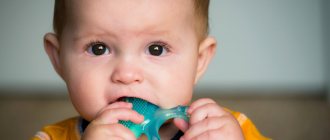What to do if your child has a fever? This question sooner or later arises in every parent who is concerned about the health of their child. But not all mothers and fathers know what temperature can and should be lowered. So, for example, in newborns and babies up to one year old the indicator is up to 37.5-38 degrees, which for us adults is considered elevated, and is the norm. The baby is one month old – does he have a fever? Reduce it only if it rises above 38-38.5.
As for older toddlers, for them this “threshold” is 39-39.5. If the thermometer shows a lower temperature, you should not knock it down. Remember that a child’s fever is an excellent opportunity for the body to fight the infection on its own. Give your baby the opportunity to boost his immunity!
How to reduce a child's temperature?
Now let’s talk about the medications that should definitely be in your first aid kit if a baby is growing up in the family. Thus, pediatricians prohibit the use of drugs such as:
- Aspirin;
- Analgin;
- Nise.
The baby can only be given medications that contain Paracetamol or Ibuprofen. Even if the child has no symptoms, they must be correctly calculated based on the baby’s weight and measured using a special syringe or measuring spoon. You should not use ordinary teaspoons for these purposes, and it is better to completely forget about the concept of “by eye”.
Description
What kind of drug is this and what is it good for? More often it is produced in the form of suppositories, which must be used rectally. They contain the following herbal and natural ingredients:
- chamomile;
- belladonna, otherwise called belladonna;
- bittersweet nightshade;
- plantain;
- meadow lumbago;
- and calcium carbonate.
Thanks to this, the medicine is considered homeopathic and safe for the health of the child. To give the desired shape and size to the candles, pharmacologically inert solid fat is used as a base, which softens at normal body temperature.
How to reduce a child's temperature?
Doctors advise using only one drug from the above - with Paracetamol or Ibuprofen in the composition. If the temperature drops poorly or does not drop at all, such medications can be alternated. But you can’t give your baby the combined drug Ibuklin.
Please note that it is not at all necessary to reduce the temperature to normal. It is enough just to knock it down a little for the baby’s well-being to improve at least a little. Don’t forget to feed your little one, because in case of high temperature the loss of fluid increases. Pediatricians say that babies need to drink 100 ml of water per 1 kg of weight.
Release form, packaging, storage conditions
Candles are produced by German manufacturers in the form of a torpedo, which has a slightly pointed end on one side and a funnel-shaped depression on the other. They come in light yellow or white. Their surface is smooth, which allows for quick and easy insertion into the anus. Candles are in blisters of 6 pieces. There are 12 of them in a package. Candles should be stored in their original packaging, in a dark and dry place where the temperature does not exceed 25°C. Take out one at a time if necessary. It is unacceptable to be in direct sunlight or near heating devices - the heat will melt the candle and it will become impossible to receive it.
What to do if your baby gets chickenpox?
Has your child caught chickenpox? Of course, this acute viral disease can also cause high fever. How to proceed in this case?
The most important thing is to choose an antipyretic drug for your baby. Under no circumstances should you use Nurofen. To combat high fever during chickenpox, medications containing Paracetamol are suitable.
What to do if your child has a fever?
Does your baby have a fever? Then you can’t hesitate - you need to urgently consult a doctor. Especially if it is accompanied by:
- rash;
- neck muscle tension;
- abdominal pain;
- vomiting.
But don’t panic: fever is typical for most common viral respiratory infections and high temperatures - about 40 degrees. This is how our body responds to infection. The pediatrician will simply examine the child and select the right treatment for him, taking into account the severity of the disease.
What temperature should be lowered in a child with influenza and ARVI?
High temperature forces the child's body to turn on its protective function. In this case, there may be a general deterioration in the form of malaise and headaches. The child becomes lethargic and whiny, which brings a lot of anxiety to parents. Before bringing down a child’s high temperature, you need to clarify significant nuances.
A slight increase in temperature does not lead to serious consequences and does not require any measures to be taken. Parents need to have reliable information about what temperature should be lowered. Improper actions can cause weakened immunity. There is a risk of developing possible complications and the disease may become protracted.
Cases when you need to bring down the temperature in children:
- 37.2-37.9°C (low-grade fever) – should be taken for newborns up to 2 months of age if indicated;
- 38.0-38.9°C (febrile) – antipyretics must be given in all cases;
- over 41.0°C (hyperthermic) - you need to call an ambulance if the drugs do not lower the readings on the thermometer.
It is necessary to call an ambulance if febrile spasms appear - this is intolerance to high temperature, an individual feature of the child’s body. This condition usually does not occur in children over 6 years of age (provided there are no pathologies in the central nervous system).
Chronic or acute diseases in cardiology, neurology or lung disease require lowering the temperature in children if the readings are above 38°C. Otherwise, complications from the heart, nervous system and respiratory organs cannot be ruled out.
If you have difficulty lowering your temperature, you should immediately seek medical help. If the thermometer has barely reached 37°C, and the child looks lethargic and his health is only getting worse, you should not expect a further increase in the readings on the thermometer.
How to properly lower the temperature at home?
Effective folk ways to reduce fever without medications in children:
- A drink made from cranberries is a unique diaphoretic that reduces fever. The berry is useful for containing vitamins and accelerates the elimination of decay products.
- Chamomile tea is an excellent anti-inflammatory remedy. To prepare the infusion, pour a tablespoon of chamomile into a glass of boiling water, let it brew for 2 hours, drink up to 5 times a day.
- Elderberry decoction effectively helps reduce fever. It is enough to take 50 g of elderberry and pour boiling water (200 ml) over it.
- Linden tea – gives excellent results when consumed with honey. The child will sweat profusely, which will reduce body temperature due to the evaporation of excess moisture from the skin.
You can wipe the child's body with a terry towel moistened with water at room temperature. Applying a heating pad with ice to large vessels helps. Wrapping in a damp towel or sheet is also recommended.
Medications
Before lowering your child’s temperature at home with medications, you must carefully study the instructions for use. Classic drugs can be bought in pharmacies, choose the dosage and form that is needed and choose the best option depending on age and indications.
The baby can only be given medications that contain paracetamol or ibuprofen. Paracetamol is contained in Panadol and Cefekon, ibuprofen is found in Nurofen and Ibufen. For babies, these products are available in the form of syrup, which, unlike tablets, has a sweet taste and is more convenient to dose.
Standard antipyretic drugs:
- "Panadol". Suitable for use on infants. The drug is indicated for colds, teething, otitis media, whooping cough and other infections. Prescribed to children aged 3 months and older in an individual dosage.
- "Efferalgan." Used as an analgesic and antipyretic. Rectal suppositories can be used to relieve fever in infants 3 months and older. Unlike medications taken orally, it does not cause vomiting and does not affect the gastrointestinal tract.
- "Ibufen." Has analgesic and antipyretic properties. In childhood, this drug is used in a dosage calculated depending on the weight and age of the child.
- "Paracetamol". An effective antipyretic and analgesic. It can be alternated with ibuprofen. If there is vomiting, you can use suppositories (suppositories).
- "Cefekon D". Available in the form of suppositories, recommended for use from 3 months to 12 years. Important advantages of the drug are its low cost and versatility. In addition to reducing temperature, it has an anti-inflammatory and analgesic effect.
A child's body can react to different medications differently, so you should experiment in practice to determine a more effective remedy, based on the pediatrician's recommendations.
When taking medications, you should follow a number of rules:
1. You cannot give several medications at the same time.
2. Drugs can be alternated, but the interval between taking medications should be 2-3 hours.
3. It is recommended to dose syrups using a measuring spoon or syringe, which are included in the kit.
4. If a child 1 year or younger is sick, it is recommended to use suppositories. Older children take tablets and capsules easily. Without a doctor's recommendation, antipyretic drugs can be prescribed to children for no longer than 3 days in a row and no more than 4 times a day.
5. Parents must understand that high body temperature is just a symptom indicating a specific disease. Taking antipyretics is not a treatment; it is only necessary to alleviate the child’s condition before the doctor arrives.
Advantages of Viburkol
This biological drug does not have any drugs similar in composition and spectrum of action. In terms of effectiveness, these suppositories can only be compared with non-steroidal anti-inflammatory drugs. The dosage form is convenient. The product is not addictive. It has no age restrictions - it is prescribed to babies from the first days of life and to fairly elderly people. At the same time, suppositories can reduce the side effects of other biological drugs. They do not disrupt or weaken concentration, and the speed of psychomotor reactions does not decrease. Pharmacies dispense medicine without a prescription.
What should you not give to children?
Reducing a child’s temperature is not difficult - today there are many drugs on sale that relieve fever in a short time. But first you need to consult with a qualified pediatrician, because self-medication can affect the baby's health.
If the readings do not exceed 38.5°C, there is no need to lower the temperature, because The body independently produces antibodies that help destroy viruses - so to speak, it fights the infection.
Medicines that are not recommended for children:
- amidopyrine, antipyrine and phenacetin (many side effects);
- acetylsalicylic acid (reduce the number of platelets, causing bleeding, allergic reactions, etc.);
- analgin and other drugs containing metamizole sodium as an active substance (side effects occur, such as suppression of hematopoiesis, severe allergic reactions, etc.).
These drugs are not recommended for use without the advice of a doctor. When you need to bring down the temperature, give preference to another medicine.
Contraindications, overdose and side effects
In some cases, Viburkol caused allergic reactions - patients developed a rash on the skin and suffered from itching. In this case, immediate consultation with your doctor is required. This could be urticaria, Quincke's edema, anaphylactic shock. Until now, information about an overdose of the drug has not been recorded. But this is not a reason to use candles in unlimited quantities.
A contraindication may only be individual intolerance or hypersensitivity to individual components of the drug.
Is it necessary to bring down a child’s temperature to 36.6?
If, after using antipyretics, the readings decrease by 0.5°C within an hour, then the process is normal. Do not aim to reach 36.6°C immediately. This can cause serious overload of the child’s body, which can lead to a deterioration in overall well-being.
The ideal temperature would be 37-37.5 degrees. After some time, a jump may occur again. This occurs because the active component of the medicine is excreted from the body and ceases its effect. If several hours have passed after taking the drug, you can give the child another dose. It is very important to observe time intervals between doses and monitor temperature readings.
With an effective fight of the immune system against pathogenic microbes and with a competent approach to treatment, recovery, as a rule, is 3-5 days.
Compound
| Homeopathic rectal suppositories | 1 sup. |
| active components: | |
| Chamomilla recutita (Chamomilla) (Chamomilla recutita (Chamomilla) D1 | 1.1 mg |
| Atropa bella-donna (Belladonna) D2 | 1.1 mg |
| Solanum dulcamara (Dulcamara) D4 | 1.1 mg |
| Plantago major (Plantago) (plantago major (plantago) D3 | 1.1 mg |
| Pulsatilla pratensis (Pulsatilla) (Pulsatilla pratensis (Pulsatilla) D2 | 2.2 mg |
| Calcium carbonicum Hahnemanni (Conchae) D8 | 4.4 mg |
| auxiliary component: solid fat (Adeps solidus) - 1089 mg, to obtain a suppository weighing 1.1 g |
How to help a child’s body fight infection?
Regardless of whether you follow the recommendations on what temperature to lower in children, you must take care to create the necessary conditions for the patient. All family members should improve the quality of personal hygiene: wash their hands, wear disposable gauze bandages, etc. You also need to provide the child with separate cutlery and dishes.
Recommendations for a speedy recovery:
1. A sick child must remain in bed.
2. It is necessary to ventilate the room in which the baby is located (the influenza virus and other microorganisms are concentrated in musty air).
3. Care should be taken to humidify the air (at the same time, the mucous membranes of the nose and larynx do not dry out; this improves local immunity and promotes well-being).
4. You should ensure that you drink plenty of fluids (virus breakdown products are eliminated through the kidneys, which reduces the load on the body).
5. The baby’s clothes should be light, preferably made from natural fabrics.
6. It is considered normal for a baby to have no appetite. You should avoid spices, citrus fruits, and dairy products, which can cause irritation of the gastric mucosa. A hot bath at a high temperature is not the most pleasant feeling, but cool (not cold) water can help normalize the indicators.
7. It is recommended to use the bath together with antipyretics, and not instead of them. You can also get some relief by applying a cool compress to your forehead.
Methods of use
Many pregnant women ask the question “Where to insert Viburkol?” The answer is simple - in any condition of a woman, these rectal suppositories are inserted into the rectum. Experiments with vaginal insertion are extremely undesirable. They begin to work quickly - almost the same as the medicine given by injection. This is explained by the fact that there are many blood vessels in the rectum, through which the medicine is quickly absorbed and distributed throughout the body. At the same time, it does not irritate the intestinal mucosa, liver, stomach, duodenum and esophagus.
Some women have difficulty inserting suppositories into the rectum; they melt quickly. This is true, so you don’t need to hold them for a long time in your hands, which first need to be washed thoroughly (the water should be cool, not hot!). You should also wash the anal area. You can use rubber gloves for this procedure. To insert the suppository, you should lie down - in this position the muscles of the anus will be as relaxed as possible. You should not lubricate the candle with Vaseline or vegetable oil - they can cause a reaction with the constituent substances of the drug. And the further effect on the body of such a mix is unknown. But it is also not recommended to use physical force - this can damage the intestinal mucosa. If you managed to insert the suppository, you need to remain in a supine position for about an hour - this way the active components can be safely absorbed.
